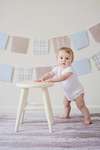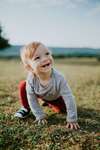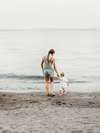Your osteo's advice on baby shoes

Looking at our beautiful little creatures with their cute little feet, it is tempting to choose their shoes based on aesthetics, fashion, the effect it will make.
However, before choosing shoes, some information should be known and it is necessary to get out of our minds the outdated recommendations of the old times.
What we said BEFORE about baby shoes:
Before, and unfortunately still now, some people think that children's shoes must be high to hold their ankles well, which is supposed to be fragile, and rigid to hold their feet well. The children were thus equipped as of the youngest age of boots with lace, of Timberland high, shoes with very rigid soles, etc.
Have you ever walked in ski boots?
Stiffening a child's foot in this way can be for us the equivalent of walking with ski boots: the step is not possible, there is no mobilization of the various joints of the foot and worse the muscles do not work or work little because they do not need it, the boots act as guards for them.
Current recommendations: free your child's foot!
Make him walk barefoot!
Barefoot walking has many advantages as listed below, however studies show that wearing shoes motivates the child, encourages him and helps him to gain confidence to walk. It is therefore necessary to choose the right shoe, that is to say a shoe that mimics the barefoot effect:
Walking barefoot will strengthen the muscles of the leg
In order for the child to walk properly, he must have muscles, he will not walk for long if these muscles are not strengthened, it is not necessary to put stakes on him, he will build up muscles as he can. In order to do this, the foot must be freed!
Have him walk barefoot as much as possible whenever possible.
- If the ground is cold, use non-slip socks or small soft slippers.
- If you go outside, use shoes with anti-slip soles and that protect from stones but as soft as possible.

Barefoot walking stimulates the sensory receptors

Walking barefoot stimulates the sensory receptors of the foot which transmit various information to the brain via the neurological pathways of superficial and deep sensitivity:
- Superficial:
- Temperature: cold, hot
- Floor texture: grass, sand, mattress, carpet, concrete. Let your child discover the different floors, he will be delighted.
- Deep:
- Balance
- Proprioception: the brain's perception of the position of different parts of the body.
- Overall body posture
A flexible shoe solidifies the bones of the foot
These are the constraints that will stimulate bone cell growth. Walking barefoot or with soft shoes strengthens the bones and does not weaken them, on the contrary, unless you jump barefoot on a big rock.
The arch support is useless in the baby shoe
Children naturally have flat feet (up to about 4 years old), so putting an arch support on them to shape the inner arch of the foot is an aberration. It is the traction of the muscles that will shape the arches of the feet and build the posture, supplementing the foot can on the contrary generate constraints on the posture.

A suitable shoe size
Again, shoes that are too small are not ideal. After a day in small shoes, we adults feel pain, and so does a child. It is therefore advisable that the child's foot is comfortable in the shoe. We recommend one size up, not two or three. Children's feet grow quickly and it is tedious and expensive to change shoes frequently, but it is worth it; you capitalize on your child's future.
Your osteopath's advice in brief
A good shoe for a baby should :
- Be as flexible as possible
- Have a sole that can be twisted in all directions without forcing
- Do not be upwardly mobile
- Mimic the feeling of bare feet
- Be protective without being limiting
- The shoe should bend at the toe

Marie Messager
Osteopath specialized in pediatrics
2 rue Alexis de Tocqueville
78000 Versailles
